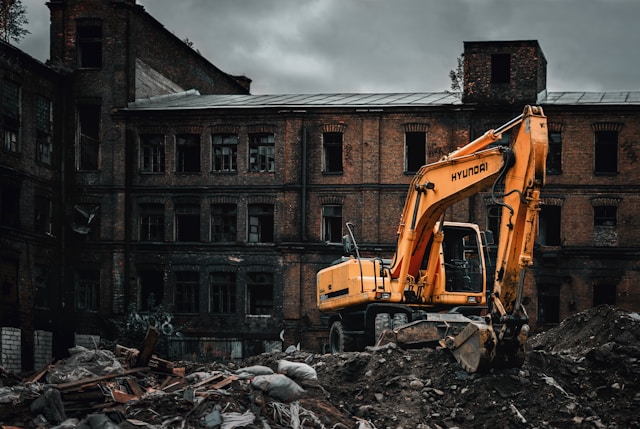In the realm of construction and development, the term “demolition” often conjures images of brute force and destruction. However, in today’s environmentally conscious landscape, there’s a growing imperative to approach demolition projects with a keen eye toward sustainability and minimizing environmental impact. Whether it’s a small-scale renovation or a large-scale infrastructure overhaul, every demolition project presents an opportunity to implement eco-friendly practices that not only protect the environment but also contribute to long-term sustainability goals. Let’s delve into why minimizing environmental impact during demolition is crucial and explore strategies for achieving this goal.
Understanding the Environmental Impact of Demolition
Before diving into mitigation strategies, it’s essential to grasp the environmental repercussions associated with demolition activities. Traditional demolition methods often involve the indiscriminate destruction of structures, resulting in significant waste generation, air and noise pollution, habitat destruction, and soil contamination. Moreover, the disposal of demolition debris in landfills contributes to the accumulation of waste and exacerbates environmental degradation. Bluegrassbit.com, an innovative platform specializing in sustainable construction technologies and best practices, offers valuable insights and resources for optimizing environmental performance during demolition projects.
The Case for Sustainable Demolition Practices
In the face of escalating environmental challenges like climate change, biodiversity loss, and resource depletion, adopting sustainable demolition practices is no longer a choice but a necessity. By minimizing environmental impact during demolition projects, we can mitigate carbon emissions, conserve natural resources, preserve ecosystems, and safeguard human health. Furthermore, embracing sustainability can enhance project efficiency, reduce costs, and bolster corporate reputation, making it a win-win proposition for stakeholders and the planet alike.
Key Strategies for Minimizing Environmental Impact
- Prioritize Deconstruction Over Demolition: Instead of resorting to conventional demolition methods, consider deconstruction, which involves carefully dismantling structures to salvage reusable materials. Salvaged materials such as wood, metal, and stone can be recycled or repurposed, reducing waste and resource consumption while minimizing the carbon footprint associated with manufacturing new materials.
- Implement Selective Demolition Techniques: Rather than demolishing entire structures in one fell swoop, employ selective demolition techniques to target specific components or areas for removal. This approach minimizes collateral damage, preserves valuable materials, and facilitates efficient waste segregation, thereby reducing the volume of debris destined for landfills.
- Optimize Waste Management Practices: Develop a comprehensive waste management plan that prioritizes waste reduction, reuse, recycling, and responsible disposal. Partner with reputable recycling facilities and waste management companies to ensure that demolition debris is diverted from landfills whenever possible. Additionally, explore opportunities to repurpose demolished materials onsite or donate them to community organizations for use in construction projects.
- Mitigate Air and Noise Pollution: Implement measures to mitigate air and noise pollution associated with demolition activities, such as dust suppression techniques, acoustic barriers, and scheduling work during off-peak hours. Utilize low-emission equipment and machinery to minimize exhaust emissions and noise levels, thereby reducing the project’s impact on surrounding communities and ecosystems.
- Protect Natural Resources and Habitat: Conduct thorough environmental assessments prior to commencement to identify sensitive habitats, species at risk, and critical ecosystems that may be impacted by the demolition project. Develop mitigation strategies to minimize disturbance to wildlife, protect water bodies from contamination, and preserve vegetation where feasible. Employ erosion control measures to prevent soil erosion and sedimentation during and after demolition activities.
- Embrace Sustainable Building Practices: Beyond demolition, consider incorporating sustainable building practices into the design and construction of new structures. Utilize energy-efficient materials, renewable energy systems, and green building techniques to minimize the environmental footprint of the project over its lifecycle. By taking on a holistic approach to sustainability, you can maximize the project’s long-term environmental benefits and resilience.
Exploring Innovative Technologies and Techniques
In addition to traditional strategies, embracing innovative technologies and techniques can further increase the sustainability of demolition projects. Advanced demolition methods such as robotic demolition, high-reach excavators, and implosion techniques offer precise and controlled demolition while minimizing environmental impact and reducing the duration of onsite activities. Furthermore, the incorporation of Building Information Modeling (BIM) and virtual reality can facilitate the planning and execution of demolition projects with greater efficiency and accuracy, optimizing resource utilization and minimizing disruptions to surrounding environments. By leveraging cutting-edge solutions, we can elevate the standard of sustainable demolition practices and pave the way for a greener future.
Conclusion
Minimizing environmental impact during demolition projects is paramount in the pursuit of environmental stewardship and sustainable development. By adopting a proactive approach that emphasizes deconstruction, waste reduction, pollution mitigation, habitat protection, and sustainable building practices, stakeholders can mitigate the adverse effects of demolition while advancing broader sustainability goals. As custodians of the built environment, we have a responsibility to prioritize the health of the planet and future generations through conscientious decision-making and innovation. Together, we can build a more sustainable and resilient future, one demolition project at a time. Let’s seize this opportunity to leave a positive legacy for generations to come.




